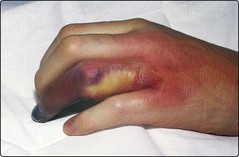43 An increased susceptibility to infection can arise from multiple factors (Table 43.1). Neutropenia and neutrophil dysfunction are probably the most important causes of infectious complications in patients with leukaemia. Unlike many other forms of immunosuppression, neutropenia is easy to quantify – the risk of infection rises appreciably at counts below 0.5 × 109/L and is greatest where the count is below 0.1. Lymphopenia and lymphocyte dysfunction are seen in lymphoid malignancy and after chemo- and radiotherapy. Defects in humoral immunity are particularly seen in patients with chronic lymphoid malignancies and in myeloma. The likelihood of infection is related to the severity of hypogammaglobulinaemia. Table 43.1 Possible factors predisposing to infection in haematology patients Cellular defects Humoral defects Anatomic defects Splenectomy (see p. 10) Bacterial infection in neutropenic patients may be overt – for instance a chest infection with a productive cough or the presence of infected skin lesions (Fig 43.1). However, bacterial sepsis can equally present with non-specific malaise and a pyrexia. In the latter case extensive cultures including blood, nose, throat, stool and urine are indicated.
The immunosuppressed patient
Types of infection
The immunosuppressed patient









